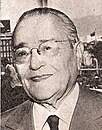September 1973 Argentine presidential election
| |||||||||||||||||||||||||||||||||
| |||||||||||||||||||||||||||||||||
 Most voted party by province. | |||||||||||||||||||||||||||||||||
| |||||||||||||||||||||||||||||||||
The second Argentine general election of 1973 was held on 23 September.
Background
The jubilation that followed the May 25, 1973, return to democracy (following over six and a half years of military rule) was soon clouded by political friction and unforeseen events. President

López Rega, formally Minister of Social Policy, quickly parlayed his portfolio control over nearly 30 percent of the national budget into a well-funded paramilitary force, the
The calculating López Rega seized on this to prevail on Vice President Vicente Solano Lima and Senate President Alejandro Díaz Bialet to resign, as well, leaving a constitutional vacuum referred to as an "acephaly" — the absence of a head of state. This move created both the need for new elections and the chance to remove a number of Cámpora's leftist advisers; it also left the nation's highest office to the President of the Argentine Chamber of Deputies (lower house), Raúl Lastiri, who was, despite being a year older than López Rega, the powerful Social Policy Minister's son-in-law. The cautious Lastiri continued Cámpora's populist socio-economic policies; inheriting a growing threat from an increasingly armed Peronist Youth and the newly-active Trotskyite People's Revolutionary Army (ERP), which, in only three months, attacked a military installation and murdered a number of military figures, he replaced Interior Minister Righi and called elections for September 23. The runners-up in the March elections — Ricardo Balbín (UCR) and Francisco Manrique (APF) — again accepted their respective party's nomination, with Manrique obtaining the endorsement of the PDP and naming its leader as his running mate.[2]
Increasing violence led many in Argentina, including much of the
Candidates
- Justicialist Liberation Front (populist): Former President Juan Perón of Buenos Aires Province
- Radical Civic Union (centrist): Former Deputy Ricardo Balbín of Buenos Aires Province
- Federalist Popular Alliance (conservative): Former Minister of Social Policy Francisco Manrique of Mendoza Province
- Worker's Socialist Party: Juan Carlos Coral
-
Perón
-
Balbín
-
Manrique
-
Coral
Results
| Presidential candidate |
Vice Presidential candidate |
Party | Votes | % | |
|---|---|---|---|---|---|
Juan Domingo Perón
|
Isabel Perón | Total Perón - Perón | 7,359,252 | 61.86 | |
| Justicialist Liberation Front (FREJULI) | 6,469,525 | 54.38 | |||
| Popular Left Front (FIP) | 889,727 | 7.48 | |||
| Ricardo Balbín | Fernando de la Rúa | Radical Civic Union (UCR) | 2,905,719 | 24.42 | |
| Francisco Manrique | Rafael Martínez Raymonda | Federalist Popular Alliance (APF) | 1,450,996 | 12.20 | |
| Juan Carlos Coral | José Francisco Páez | Worker's Socialist Party (PST) | 181,474 | 1.53 | |
| Total | 11,897,441 | 100 | |||
| Positive votes | 11,897,441 | 98.69 | |||
| Blank votes | 108,785 | 0.90 | |||
| Invalid votes | 49,412 | 0.41 | |||
| Total votes | 12,055,638 | 100 | |||
| Registered voters/turnout | 14,312,405 | 84.23 | |||
| Source:[4] | |||||
References
- ^ a b Page, Joseph. Perón: A biography. Random House, 1983. [page needed]
- ^ Todo Argentina: 1973. (in Spanish)
- ^ Martínez, Tomás Eloy. La novela de Perón. Random House, 1985. [page needed]
- ISBN 950-685-009-7.







